We're back from Paris, and we're almost recovered from the complete lack of sleep! (erg! That part was written between Paris and Rome, so we're also back from Rome and recovering from that lack of sleep)
 |
| Train 1 / 2 - The Express from Leicester to London St. Pancras Station. |
Last weekend we finally made the trip down to Paris, and just in time, as we only caught the last three days of Paris in the Spring.
We did the truly British thing, and took the train from Leicester, down to St. Pancaras Station in London, then across the platform, and into the high-speed Eurostar direct to Gare du Nord station in Paris via the Chunnel.
 |
| A light refreshment for the ride |
I have to say it was a more comfortable way to travel. There are very few luggage restrictions (we didn't go overboard, but did have a travel backpack with us). Much more exciting though was that we were able to bring a full bottle of wine, and an entire spread of meats, cheeses and bread for a picnic on the Train. As you can see, we were able to (strategically) score a seat with a table.
 |
| This is an unflattering photo of Kris, sorry, but it's the only one that shows our spread of goodies. |
Once through the EuroTunnel (or Chunnel as everyone knows it), we realized that we weren't exactly moving at the top speed. What turned out to be our first experience in Paris, was a 90 minute delay on the Eurostar due to a labour disruption. We think some people, protesting the gov'ts proposed changes to the French labour laws stormed the platform at Gare du Nord, and caused all trains to halt in place and hold till they could all be removed. It's possible there was a high voltage power source that had been shut off too. In any case we had our 1/3 of a bottle of wine remaining to help us muster through, and an Ipad full of movies set in Paris. At last we arrived, and made our way to the AirBNB to catch some sleep and prepare for a busy day ahead.
We didn't end up inconvenienced in any other ways by the labour strikes that are happening across the country (the unions have stepped up their strikes and walkouts to coincide with EuroCup Football going on right now in France), but we did change some of our plans so that we weren't affected. Earlier in the week, the staff of the Eiffel Tower failed to show up to work, so they closed the tower for the day. We didn't want to miss out on seeing some of the most famous sights, so we hit them first, in case they were closed later.
First stop is the Eiffel Tower. The most recognized symbol of Paris and arguably France.
 |
| Part of the catwalks that we walked up to the first and second stages. |
 |
| The elevator is actually a three decker. The top two are for passengers, the bottom is this statue of an operator riding along.... one more thing you only see when you're walking up. |
Some of my favourite facts about the tower:
Gustave Eiffel (designer / engineer of the tower) had his own apartment located at the top level (observation deck) of the tower. It included a work room, bedroom, and lab for him to complete science experiments.
The tower was the tallest structure
in the world from it's construction in 1889 until 1930, when it was surpassed by the Chrysler Building.
(Literally just found out tonight) Today, the Eiffel Tower is taller than the Chrysler building by 5.2 m, because of the addition of broadcast antenna to the tower in 1952. (take that you Americans!)
But now I've gotten ahead of myself....
 |
| The Champs de Mars. As you can see, they turned this into a huge fan zone for Euro 2016. |
 |
| The River Seine (looking South) |
So the tower was originally constructed in 1889 as an entry to the Worlds Fair in Paris, which coincided with the 100 year anniversary of the French Revolution.
Much has been written about how the tower was decided upon (it seems there may have been some corruption in the terms of the tender), but once selected, Eiffel himself actually put down more than 1/5 of the total cost of the tower from his personal funds.
 |
| A little helpful wayfinding |
 |
| Les Invalides, Sacre Coeur on the hill in the distance on the left (see part deux), and somewhere out there is Notre Dame too. |
The idea was not without controversy of course, as this would be by far the tallest structure in Europe. A group of artists and architects penned a lovely letter in
Le Temps to express their disdain:
We, writers, painters, sculptors, architects and passionate devotees of the hitherto untouched beauty of Paris, protest with all our strength, with all our indignation in the name of slighted French taste, against the erection … of this useless and monstrous Eiffel Tower … To bring our arguments home, imagine for a moment a giddy, ridiculous tower dominating Paris like a gigantic black smokestack, crushing under its barbaric bulk Notre Dame, the Tour Saint-Jacques, the Louvre, the Dome of les Invalides, the Arc de Triomphe, all of our humiliated monuments will disappear in this ghastly dream. And for twenty years … we shall see stretching like a blot of ink the hateful shadow of the hateful column of bolted sheet metal.
(we should write like that more often).
 |
| An engineer, in a tower, admiring a river. So civil! HA! |
Of course the naysayers turned out to be wrong, and today, the Eiffel Tower is the top tourist destination in Paris.
This was the case from the first day it was opened. By the end of the World Exhibition, nearly 2 million visitors had climbed the tower.
It is rumored that one of the most vocal critics of the design of the Eiffel Tower, choose to take his lunch in the tower restaurant daily for years, because it had the best view of Paris, being the only location in which the Eiffel Tower was not visible ;)
 |
| It's kinda amazing both things here: 1) How many different ways you can profiteer off of the image of the Eiffel Tower, and 2) how good the French are at making sculptures out of Macaroons (or Luxemborglies in Switzerland, Pastilles in Canada). |
 |
| The Arc de Triomphe |
 |
| Palais de Chaillot |
 |
| The gold dome in the distance is Les Invalides. Notice how all the buildings are made of white stone... that's important for our next stop. |
Since that time, the tower has become the symbol of Paris. As was alluded to earlier, it was only meant to stand for 20 years, before being dismantled, but with the advent of wireless radio, it was saved from demolition by the addition of radio antenna to the top. Now it's the beacon for most cell phones, radio transmission, TV channels and who knows what else, that broadcast from the top of the tower.
 |
| These are the radio antenna that project from every side of the top of the tower. |
 |
| The blue dashed line is the height of the Eiffel Tower. Haha! Canada Rocks! |
For our visit, we opted (and I highly recommend) walking up the first two stages of the tower. There are several great reasons to choose this option, first is the exercise. At more than 600 stairs to the second level, it definitely gets your heart going. We saved a few euros by not taking the elevator, and we were able to admire the construction at a slow pace, taking time to rest, and marvel at the thousands of pieces that came together to make the tower. Lastly, we didn't have to wait in a line either ;) From the second level to the top, you get into the same line as everyone else for the last elevator. Then you can take any method you like to get to the bottom.
 |
| This is just the second stage on our way back down, not even the top. |
 |
| Symmetric and beautiful! |
 |
| Mr. Eiffel himself! |
 |
| He's my homeboy |
 |
| We're not actually sure who the names on the side of the tower are commemorating. |
The view is remarkable, as you can imagine. I'll let the photos speak for themselves. From an engineering perspective, it's an elegant design in which function and form combine to create something really quite stunning.
 |
| Even the tower isn't spared from Euro 2016 hype. It's a huge soccer ball suspended under the second stage. |
From the Eiffel Tower, we made our way over to the Catacombs of Paris. You may have noticed in the above pictures, that most of the buildings in Paris are made of white stone. Similar to Malta, you build with what you've got. Paris sits on a large deposit of limestone below the city, and 200-300 years ago, this stone was mined via tunnels under the city. When mining operation stopped, in the late 1700's, the mine shafts and tunnels were not filled, but simply abandoned, and nearly forgotten. That is until numerous collapses of the aboveground city made action necessary. Engineers descended into the tunnels and began reinforcing the tunnels to ensure they remained safe to the citizens living above.
 |
| The limestone mine caves |
 |
| With dates carved into the walls to indicate when that section had been originally dug |
 |
| Ventilation shafts (these went back at least 15 feet, and to where after that, I don't know. |
 |
| And wayfinding, so you knew which street you were presently under. |
 |
| We only saw a very small part of the remaining tunnels. The majority are closed off to tourists. |
At the same time, Paris was facing a crisis. The cemeteries were literally overflowing with remains. Trying to find a solution to two problems, it was decided that the limestone tunnels, with a relative humidity of approximately 0%, would provide perfect conditions for an ossuary, a room in which the bones of the dead are placed.
Once the ossuary itself was constructed, the skeletal remains of nearly 6 million people were relocated over the next 80 years from graveyards around the city to the underground repository, where they remain to this day.
 |
| ARRETE! C'EST ICI L'EMPIRE DE LA MORT |
The ossuary itself makes up about 1/3 of the crypt tour, which includes about 2 km of walking under the streets of Paris. I have to say, it was beautiful, but in a slightly disconcerting way to see just how many remains are located in the ossuary, and the way in which they have been arranged. For the most part, the femurs and tibia of the dead are arranged flush to the walking path, to form a corridor, with the remaining bones deposited behind the 'wall'. In many places, the skulls are arranged along the top of the 'wall', and in some instances, used to form decorations within the wall (crosses and patterns).
Once again, the photos probably say more than I can. The bones are arranged into sections based on where they were originally laid, and a plaque identifies the original cemetery and date the remains were brought to the ossuary. We were able to find the 'original' or the first set, placed there in 1791.
 |
| This is the first section of the ossuary to be filled. The plaque was placed just 2 years after the ossuary was originally opened. |
 |
| Other plaques identify different cemeteries, waypoints and dates |
 |
| One of only a few examples of skulls with jawbones intact. |
 |
| The scale, when you think about it, is remarkable. Yes, those are skulls lining the way on both sides. |
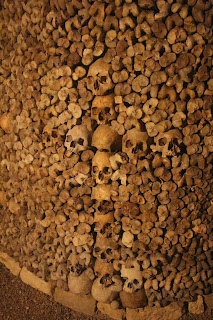 |
| Ornamentation |
 |
| The designs are perhaps the most incredible. |
 |
| Kris identified the markings from when the skull fused during infancy. |
 |
| This is one way to decorate (hide) a column. |
 |
| This is one of the vaults, which were collapsing, and caused the city to address the empty tunnels underneath the city. |
 |
| After all that, who wouldn't expect them to have a dark sense of humor! |
 |
| Before moving on, I finally ordered myself a café noisette. Yes, translated it is hazelnut coffee, but in Paris, it's just an espresso with a bit of hot milk added. |
 |
| Hey! Look what I found, Ketchup chips! Just out there right in the middle of the grocery store. Man this feels like home! |
 |
| Well middle of the grocery store is a bit of a relative term. |
So who wouldn't be hungry now!
We made our way towards the Montparnasse Tower area, and had crepes on a street, that seriously could just be called the crepe district. We turned onto the street, following our google map, and spotted a crepe shop. Perfect, that must be it.... wer... wait... that's the wrong name, oh, theres another right next door... nope, still not the right name.... <eyes scan the street> holy hell, there are at least 10 crepe shops along this quite small street! Not sure how that came to pass, but if you want crepes, we can point you to a street to find them.
Part of the adventure we've had throughout our trips around Europe this year, is the innocent mis-communications that happen. The moments where what you thought, and what is real suddenly reveal themselves to be a wide gulf apart. Such was the case when we (well ok, I) ordered a savoury Andouille Sausage crepe (there was some other stuff in it too). Having had Andouille sausage at home (or at least i think I know what it was), I was a little surprised to find rather unprocessed parts of intestine added to my crepe. As with any new experience, both Kris and I vowed to eat it first, then ask questions afterwards, which is when we found out what we'd really ordered. Luckily, Kris' salted butter caramel crepe was promptly served up, and 'cleansed' our pallet.
The next two hours we spent walking around. We saw the Luxembourg Palace, where the French Senate sits.
We also, not accidentally, got these photos in front of one of the last remaining standard metres. When the metric system was introduced, people didn't have accurate measuring devices, so 'standard' metres were installed, where your measuring stick could be calibrated.
 |
| No one can ever second guess me when I say I know exactly that it was this big! |
 |
| You can see the decimetre, demi-decimetre (5 cm), centimetre, and demi-centimetre markings |
We also walked to, but were past opening hours of the Parthenon and the University of Paris reading room (those photos will be coming in Part Deux).
The last place we visited for the night was to ascend to the observation deck of the Mont Parnasse Tower. It is a 60 storey business tower, with a bar and observation deck on the top floors. If you've ever seen a photo of the Eiffel Tower, it's probably been from this building. Similar to the critics of the Eiffel Tower, Mont Parnasse is said to have the best view of Paris, with many insisting it's because it's the only place from which you can't see Mont Parnasse Tower. A good insult, it seems, is timeless.
There are a lot of photos from up here. Believe it or not, I've significantly cut down on the total number of pictures taken. These are some of the best.
 |
| Eiffel Tower with the Champs de Mars Fan Zone in front. |
 |
| Eiffel Tower and Champs de Mars |
 |
| Palais de les Invalides |
 |
| A storm was brewing on the horizon, but skipped north of us. |
 |
| Luxembourg Palace in the foreground. |
 |
| Cemetaire de Mont Parnasse |
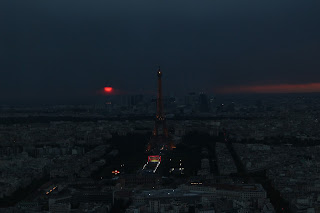 |
| The last moments of sunlight |
The first display was an explosion of white lights followed by a lighthouse-style rotating beacon, and the second, to coincide with the Euro Cup, was a display of many of the countries playing (either in the tournament, or that had played that night).
 |
| It was fun to see all the street lights come on and the roadways become a ribbon of yellow throughout the city |
 |
| The lighting between shows |
 |
| The start of the second show |
 |
| Multi-colour |
 |
| Italy (notice the screen in the fan zone is matching the colours on the tower) |
 |
| Sweden |
 |
| The Netherlands |
 |
| I think this was becoming Spain, but we missed the yellow |
 |
| Aaaaannd Sparkles! |
The view of the Eiffel Tower, and, really, all of Paris was breath taking. We spent about 1.5 - 2 hrs up here, partly enjoying the view, partly enjoying the wine, and partly so we can catch two of the light-shows that happen with the Eiffel Tower. Like the CN Tower, the Eiffel Tower has been fitted in recent years with thousands of LEDs, which can create any pattern or colour to the Eiffel Tower. In order to avoid being too garish, they only do a different light show for 5 minutes, each hour on the hour.
Starting off the second day, Kris had a bit of a sleep in, while I did my Euro-capitals run. Those may make up a full post at the end of the trip.
We started our day off with a croissant and an espresso. We did what the true Parisians do, and bought our croissant at the place next door, and sneakily ate it while we sat on the patio of the place we ordered coffee from.
We then had a bit of re-jigging of our luggage, as we were spending the last night in Paris at the flat of one of my classmates.
 |
| The lift in Vincent's apartment is the smallest elevator either of us have been in. My shoulders touched both walls at the same time. |
Once everything was settled in, we headed off for Notre Dame du Paris.
As we found out, when you say Notre Dame to anyone not in Paris, they immediately say, "Oh Notre Dame Cathedral in Paris, how lovely". When you say it to a Parisian, they ask, which one. Notre Dame translates to Our Lady, so think of how many times you've heard a church called, Our Lady of... Lourdes, Chastity, Faith, Fatima, The Angles... etc. So Paris has many a Notre Dame, but only one that is the Cathedral of Notre Dame on Ile de la Cite.
 |
| There will be a post of failed selfies... this nearly made the list. |
Located on what was the original site of Paris when it was just a fishing port, construction of ND began in 1163, and wasn't 'officially' completed for nearly 200 years, until 1345.
It is widely regarded as the best example of French-Gothic Architecture. The two features most commonly associated with the cathedral are the flying buttresses which brace the nave and the choir of the cathedral, and the gargoyles and chimera which decorate it's exterior. The flying buttresses were not originally intended, but were installed because a new construction technique was being tried, which significantly reduced the thickness of the walls, in theory, allowing the church to rise higher. As aspiration for this great church exceeded the planned strength of the walls, cracks and fractures became evident, as the walls buckled outward. The buttresses were added to stiffen the walls and permit the final height of the cathedral to be achieved.


The cathedral underwent many stages of construction right up to present day to maintain, and modify the building. My personal favorite was when the chapels were added. The inside walls were originally about 15 feet closer to centre, but when it was decided that various saints and causes were in need of separate altars and chapels, the walls between the buttresses were extended out, and the altars created. No different really than putting on a sunroom on the back of your house. Some of the altars are shown in these photos.
 |
| This is the main entrance on the west facade of the cathedral |
This cathedral has got some serious stained glass too.
 |
| Flying Buttresses |
 |
| And some of the gargoyles visible on the ends of the buttresses |
 |
| A little more of the gargoyles and architecture around the East end of the cathedral |
We didn't stay too long as we arrived just in time for a noon service to being. We quietly walked around the outside, but didn't wander the mid-section too much so as not to offend anyone.
Our last stop on my tour of Paris was for some gelato. With Italian neighbours, you can't help but share some culture. I definitely enjoyed the wine, espresso and gelato. We kept seeing signs for restaurants indicating they had gelato from this one place, so rather than try it second hand, we went straight to the source, and tried it from the shop window.
The best part about these kinds of gelato shops, is they have unique flavours. Kris and I both had a scoop of roasted pineapple and basil. I added a scoop of salted butter caramel, and Kris had blood orange. Definitely the kind of late morning snack that will carry you another few thousand footsteps, and onto lunch.





















































































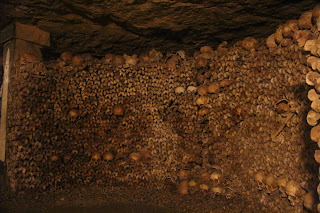

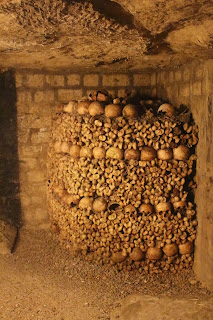






















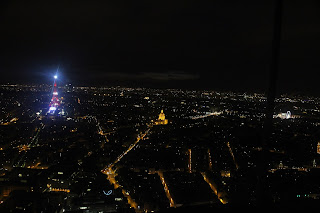
























1 comment:
Loved this post! :) I think my favourite sentence was "An engineer, in a tower, admiring a river. So civil! HA!" I also now know what Andouille sausage and buttresses are. Yay! Kris you look so happy in all those Eiffel Tower pictures ... Justin, why aren't you as happy!?!?!
Post a Comment